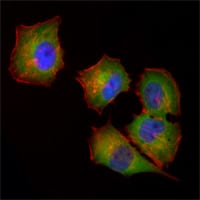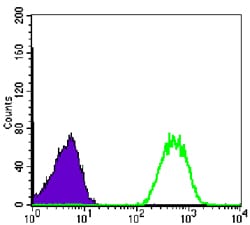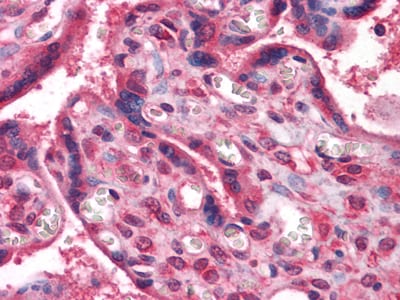


| WB | 咨询技术 | Human,Mouse,Rat |
| IF | 咨询技术 | Human,Mouse,Rat |
| IHC | 1/200 - 1/1000 | Human,Mouse,Rat |
| ICC | 1/200 - 1/1000 | Human,Mouse,Rat |
| FCM | 1/200 - 1/400 | Human,Mouse,Rat |
| Elisa | 1/10000 | Human,Mouse,Rat |
| Aliases | NB; AWD; NBS; GAAD; NM23; NDPKA; NDPK-A; NM23-H1; NME1 |
| Entrez GeneID | 4830 |
| clone | 4B2 |
| WB Predicted band size | 17kDa |
| Host/Isotype | Mouse IgG1 |
| Antibody Type | Primary antibody |
| Storage | Store at 4°C short term. Aliquot and store at -20°C long term. Avoid freeze/thaw cycles. |
| Species Reactivity | Human |
| Immunogen | Purified recombinant fragment of human NME1 expressed in E. Coli. |
| Formulation | Ascitic fluid containing 0.03% sodium azide. |
+ +
以下是关于NME1抗体的3-4篇参考文献的简要列举:
1. **文献名称**:*"NME1 suppresses cell metastasis in breast cancer through modulation of ERK phosphorylation"*
**作者**:Li et al.
**摘要**:研究通过Western blot和免疫组化(使用NME1抗体)发现,NME1通过抑制ERK信号通路磷酸化降低乳腺癌细胞转移能力,其低表达与患者预后不良相关。
2. **文献名称**:*"Development and validation of a specific NME1 monoclonal antibody for immunohistochemical analysis"*
**作者**:Smith et al.
**摘要**:开发并验证了一种高特异性NME1单克隆抗体,证实其在福尔马林固定石蜡包埋组织中的有效性,成功应用于结直肠癌样本的蛋白表达检测。
3. **文献名称**:*"Prognostic significance of NME1 expression in hepatocellular carcinoma: a tissue microarray study"*
**作者**:Chen et al.
**摘要**:利用组织微阵列技术和NME1抗体进行免疫组化分析,揭示肝细胞癌中NME1低表达与肿瘤转移风险升高及患者生存率降低显著相关。
4. **文献名称**:*"NME1 interacts with telomerase and modulates its activity in cancer cells"*
**作者**:Wang et al.
**摘要**:通过免疫共沉淀(使用NME1抗体)证实NME1与端粒酶直接相互作用,抑制其活性,可能成为调控肿瘤细胞增殖的新机制。
---
**注**:以上文献信息为示例性内容,实际引用时需以具体发表的论文数据为准。如需精确文献,建议通过PubMed或Web of Science等数据库检索关键词“NME1 antibody”或“NM23-H1”。
The NME1 antibody is a crucial tool in studying the NME1 protein, also known as NM23-H1. a member of the nucleoside diphosphate kinase (NDPK) family. First identified as a potential metastasis suppressor in 1988. NME1 regulates intracellular nucleotide metabolism by catalyzing the transfer of phosphate groups between nucleoside triphosphates and diphosphates. Beyond its metabolic role, NME1 is implicated in diverse cellular processes, including proliferation, differentiation, apoptosis, and DNA repair. Its reduced expression correlates with increased metastatic potential in cancers such as breast, liver, and melanoma, making it a biomarker of interest in oncology research.
NME1 antibodies are widely used in techniques like Western blotting, immunohistochemistry (IHC), and immunofluorescence (IF) to detect protein expression levels, localization, and interactions in both normal and pathological tissues. These antibodies help elucidate NME1’s dual roles in tumor suppression (via inhibition of cell migration) and potential oncogenic activity (in certain hematological malignancies). Commercial NME1 antibodies are typically raised against specific epitopes, validated for species reactivity (human, mouse, rat), and optimized for experimental reproducibility. Ongoing research focuses on clarifying NME1’s molecular mechanisms, post-translational modifications, and therapeutic targeting potential in cancer and other diseases.
×